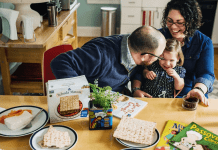My husband and I have walked into my late mother-in-law’s house for the last time.
We are in the process of settling her estate, including the sale of her house and disposition of everything in it.
From a hutch filled with china and crystal goblets to overflowing jewelry boxes and coin collections. And everything in between.
A lot in between.
Her clothes. The Notre Dame sweaters my late father-in-law was so fond of wearing. Her furniture. Furniture inherited from her mother-in-law, still in the same place in the garage where it was originally placed 30 some-odd years ago. My husband’s Cub Scout uniform. Christmas decorations. Lots and lots of Christmas decorations.
Every room, every closet, every shelf, every drawer. Full of stuff. A lifetime of stuff. Two lifetimes, if you count my father-in-law, who passed away 11 years ago.
What to Do With a Lifetime of Stuff
My mother-in-law was a neat and tidy housekeeper. But like many of us (myself included), she lived in a good-sized house with plenty of room to accommodate stuff. Things inherited from her parents and her in-laws. The broken vacuum cleaner waiting for repair in the back of the closet. Hundreds of books read once. You get the picture.
And the cost of disposing of all of that stuff? Having the estate sale company we hired go through every room, every closet, every drawer, separating the trash from the treasures, may cost more than will be generated at the eventual estate sale.
Her house has been transformed into a store, the estate sale company having cleverly arranged and displayed my mother-in-law’s possessions on tables in every room.
All of her possessions with any value, save the very few we kept, each with a tiny white price tag.
Losing your last surviving parent is hard enough. But being the arbiter of which of your parents’ and grandparents’ treasures get saved and which end up sold, donated, or in a landfill? gut-wrenching.
The lesson we have learned from this experience?
Most of the stuff in your house is worthless. And eventually, someone, either you or your kids, will be tasked with the overwhelming job of getting rid of it.
Most of Your Stuff Is Worthless
Most of the stuff in your house is worthless.
Yes, even the stuff you worry the most about, the stuff you think is so good you don’t use it for fear of breaking it, has little to no resale value.
From china, china cabinets, crystal goblets, silver tea sets, pianos, and collectible figurines like Hummels, to grandfather clocks and real pieces of craftsmanship furniture.
Why? Baby boomers have glutted the market with their castoffs, and millennials, the next generation of buyers, don’t want it.
Millennials hate both formal in-home entertaining and use of second-hand goods. With looming student loans, they tend to rent and move often. Who wants to be constantly moving a piano and a grandfather clock from apartment to apartment?
And furniture? There’s no market for so-called “brown furniture,” meaning any furniture (regardless of quality) other than the “mid-century casual” furniture (think clean, lightweight) favored by millennials. Brown furniture is basically firewood.
If it’s not in great condition, it’s also not fit for donation because it can’t be resold.
All of my mother-in-law’s furniture (including the pieces inherited from her mother-in-law and kept for decades)? Straight to the landfill.
Well, Almost Everything…
What do guns, LPs (records), and precious metals/gems have in common?
They are 3 things you might have in your house with a robust resale value.
Silverware also has value, but only if it is real silver and can be melted down.
3 Things You Should Be Doing NOW to Reduce the Amount of Stuff You Have
1. Be viciously thoughtful about holding onto sentimental items.
Here was our goal with sorting through my mother-in-law’s things. Keep just enough to remind us of her, but not so much stuff that our daughters are going to be dealing with it 40 some-odd years from now.
Here’s what we kept:
- A painting to be displayed in our dining room
- My mother-in-law’s treasured Swarovski crystal animal collection (all of which were given to her by her children and grandchildren over the years)
- Jewelry to be divided among the granddaughters
- Each of our daughters got to select 1 item
And that was it.
Well, almost. We did set aside photos to be digitized (with the originals then destroyed).
Was it hard leaving everything else? You bet it was. But we don’t want to be dealing with a lot of stuff years from now (or worse, leaving it to our daughters to deal with).
I try to be viciously thoughtful with my own sentimental items. For example, I don’t save any school papers or art projects from my kids (though I do take photos of my favorites).
2. Buy fewer books.
While used book resellers like Half Price Books do an important service in keeping books in circulation, a surprising number of books end up in landfills because many paper recycling facilities can’t process the the glue that binds book spines.
My resolution last year was to cut down on my book consumption by only reading books that I borrow from the library or purchase on my Kindle e-reader. If you haven’t used a library in years, now is the time to go back. My local library has an app where you can “order” books online, and pick them up the next day on a special “hold” shelf strategically placed next to the check-out kiosk.
How successful was I on my resolution? I read 1 to 2 books a week in 2019, only 1 of which was a hard copy purchased from Amazon.
3. Buy fewer, but better quality, clothes
The world is overflowing with used clothing.
We buy substantially more clothing over our lifetimes than our grandparents did.
Clothing made today is meant to last no more than a few years. In fact, a lot of clothing isn’t even made to withstand more than a few washes.
Think you are “paying it forward” but dropping off a load of unwanted clothes at Goodwill? Think again. Most clothing donations never make it to the racks at Goodwill and only about a third of what does eventually sells.
To really pay it forward, cut down on the amount of clothing you have by buying better quality clothes that last longer.
Keeping What Really Matters
My 5-year-old chose to keep a Christmas music box from her Grandma’s house. It plays “White Christmas” and has tiny ice skaters going around a rink inside. Each Christmas, my mother-in-law would bring out this music box and let each of her granddaughter’s play with it. It’s value in preserving a precious memory of Grandma? Priceless.














The author must live in an alternative universe! We go to Estate sales regularly
All the items the author says are worthless including brown furniture & China are snapped up albeit at a fraction of new prices
I agree. A huge market for these quality decorative objects. Not everyone want cheap ply board furniture, plastic dishes and throwaway aluminum pans, etc.
I had the same thought at first. But having gone through 3 grandparents’ homes, the value to the owner/seller of the belongings is minimal, as the folks buying Or auctioning the items are getting the bargain or a cut of the profit. The value for the homeowner is in being free of the burden while you can enjoy said freedom, not waiting until you’re dead and leaving the burden behind.
Yes!!! Rareity of glassware and preserving history matters also!!!
That’s what I was thinking!
Probably depends on the region ya live in. Now, what are your kids gonna have to deal with after reading this article?? Been there, done that when parents died. No fun. The only things we saved were jewelry and antique furniture. Sad but true. Altho I did keep my Mom’s cookbook collection. WOW! Now what? I know I’ll never use ’em all so gonna donate ’em to the library and museum (for the real old ones).
I agree …..don’t get rid of everything like this arthur suggests….she apparently doesn’t cherish items of the past…it upset me when she said she destroyed original photos after she took her own pictures….
Totally agree with you!
Totally agree. And, it’s furniture built to last, by hand, not to be disposed of just because most of us are ‘sheeples”, and must have the newest trend!
Most clothes donations never make it to Goodwill??? I think she just phoned this one in!
I hear you!!!!!
At some point in the not too distant future all these so-called “worthless” treasures will be appreciated again. People are going to get tired of “cheap”!
I agree. She’s off base on a number of levels. My kids want my stuff, not all of it of course but some things retain value, even if prices rise and fall. Estate sales abound, and most are crowded; that tells me all I want to know.
Agree with you Dave!!!
Agreed! Goodwill and Arc still take and sell most items. My in-laws are both gone and we are now dealing with their stuff so I wanted to see what this article said.
I agree this article is ridiculous! I can’t imagine Any family that would trash family keepsakes photos and things. Sounded like there were lots of other family members that they could have shared with more then what they said.
1000 times yes! We got a taste of this for ourselves and our OWN stuff. Our family of 7 got to where living in the US was more expensive than we could afford, so we opted out of government assistance or moving in with family and relocated to Costa Rica.
But in the process, we had to get rid of 15 years worth of stuff. Pfaltzgraff dishes. Bed linens. Doll houses. Breyer horse figures. Christmas village pieces. LOTS of Christmas ornaments. ALL our furniture except a china cabinet belonging to my husband’s grandmother. Even the wooden porch swing my husband made by hand that I sat on when he proposed. And so much more.
Even with only 15 years to accumulate stuff, it still took us about TWO MONTHS of weekly garage sales on Friday and Saturday, with the last week doing a 4 day marathon from Thursday to Sunday, all to get rid of it. Every weekend, my husband would load up our minivan with stuff to donate and cart it off to a local thrift shop.
It was so hard, yet freeing to get rid of all that stuff. We kept baby blankets given to my kids by their grandmothers, scrapbooks and a handful of other things.
Now that we’re back in the US, the accumulation has happened again. We did buy smarter this time, favoring more used than new items, but it is starting to feel oppressive. Even our kids have learned not to hold onto stuff…at least, most of them, anyway.
I think what most people don’t realize is how their stuff owns them, not the other way around. We could leave our home tomorrow and not give a second thought to 99% of what we would leave behind.
It IS hard to find people who understand this.
Those unwanted pieces of furniture might be just what a family starting out might need. Give it a chance before you toss! We used to live near Sedona and sales there were awesome. People furnish their new forever homes with high end items. Three years later they move away and sell everything. Recycling is good!
A good read, and very true. I’m a hoarder ??
With 2 hire units for storage and a garage full, after reading this I’m now going to be a clearer, it’s given me the push I needed, my poor children all grown up won’t want my stuff, and will have one hell of a job sorting it, thanks for the kick up the backside I really needed. ???
My husband and myself are seniors now, and we have accumulated tons of ‘stuff’ over the years of looking after apt. buildings, and keeping ‘good stuff’ that was left in empty apartments. Now we are overloaded with ‘stuff’ that would probably bring in some money, and leave us cleaned out of ‘stuff’, but we have no idea how to set up a yard sale. Also tons of clothes that are still in good shape, but will never be worn again, and some that were never worn and are brand new. Boxes of trinkets from my corner curio cabinet, ‘stuff’ that I didn’t unpack and put in the cabinet this time. It’s still boxed, and not even missed. There is only one item from that cabinet that I would keep but to give it to my daughter. We are overwhelmed by the amount of accumulated ‘stuff’. The author might be right about some things, but also way off the mark about the worth of many items saved. Not speaking about thousands of dollars or even worth hundreds of dollars. But if you sell 100 items in a day, at anywhere from $5.00 to $20.00, you are still making a nice little bundle for the treasure box you saved…lol.
Any way you spin it, it’s still all about trends.
The irony about today’s trends is that the “clean, slick” and manufactured furniture today is not made to last one lifetime, much less generations. If your choices are made to be conservative and eco-friendly, look at the furnishings that were made to last – probably those “brown” described.
You totally left out “Generation X”, (Born between ’61 and ’80).which is the generations my son hails from. Many of those people DO care about antiques and the furniture that has been passed down thru so many generations… It’s such a shame that young people now had rather have cheap, low quality furniture, when the furniture of our ancestors was crafted from real wood, and made to last…. I am in the process of “downsizing” a lot of the “stuff’ I have accumulated over the years, and even though there is a LOT of stuff that my son might not want when I am gone… stuff that might not bring a dollar at a sale.. there are things that I love, things that make me happy when I look at them.. So while you, and others may say they are worthless and that I should get rid of them.. sorry, I will hang on to the things I love and when I’m dead and gone, my son can decide what he wants to keep, sell or give away.
And…let us not forget those roadside items that may well fit an “immediate” need.
Now in my second, or is it third, downsizing
…many observations in the article certainly ring true.
Author definitely does not understand millenials. Bunz is a phenomenon because millenials believe in second hand and reusing, reducing and recycling. Also dinner parties are the thing! Thanks Karen, I mean Siobhan.
I’m 40 years old, and my mother is a hoarder and my father a packrat. They’re divorced, which means as the only non-disabled child of theirs, I’ll have to sort through two houses of stuff. I have my own family, and we have our own stuff.
To everyone who is acting like people are ungrateful when their senior relatives leave them a hoarded house full of stuff, I have a few questions for you:
1. Why do you think Millenials and Gen Z shouldn’t be able to have their own tastes and decorate how they like? The Baby Boomers and older generations got to shop for their own stuff, and decorate how they wanted. So why can’t younger people? They don’t deserve to decorate and furnish their homes to suit their tastes?
2. For those of you who think that refugees, domestic violence victims and Millennials should just take the cast-offs of previous generations, did you ever want anything new, that you picked out for yourself? Ever?
3. How big do you think the apartments are that refugees, single parents, and Millennials/Gen Z are? Do you think they can accommodate that huge oak table that’s 84″ long and has 8 chairs and a coordinating china hutch? Here’s a hint: NOPE.
4. Do you think it is fair to leave your children or grandchildren with a hoarded house to clean out, when they have their own: jobs to go to, houses to clean, children to care for? Where are they supposed to find the time to take care of the stuff you were too lazy or full of yourself to take care of when you had the chance?
5. How big do you think other people’s houses are? I have a 2,000 sq ft house. I sure can’t accommodate the cast off furniture of my parents or inlaws. Then you’re going to yell at me when I say I don’t want it, because I don’t want to live in a hoarded house like you did?
This is not a question, but a point. Not everyone treasures their relatives or their relatives’ stuff. Some of us were abused. Some of us had parents who walked out. Why would we want to hold on to their stuff when it is filled with toxic memories?